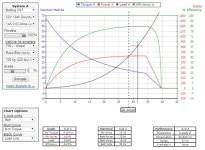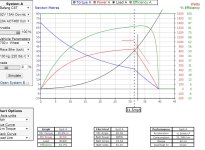Background:
--I'm an experienced road cyclists and have been commuting for a couple decades. I'll be starting a 50 mile daily round trip commute this fall and want to build a high speed, pedaled (+200-250W human power), lightweight road ebike. I want to average 25 mph and so cruise at 30 mph in flats. (I realize this speeds may make some folks nervous, but on my short commute they're already commonplace to me.) Calculators show that I need around 700W to achieve this, or about 500W of additional power.
--chas58 turned me onto geared hub motors (https://endless-sphere.com/forums/viewtopic.php?f=28&t=89455), and I'd like to build something like his high-speed commuter (https://endless-sphere.com/forums/viewtopic.php?f=3&t=49691), except about 5mph faster.
--I understand that DD motors can operate more efficiently, but I'm having trouble a) giving up the ability to freewheel, which also affords efficiency, and b) putting on a rear wheel that weighs as much as the rest of the bike (!).
I've simulated three geared hub motors with 52V/14S batteries: the Q100 CST 328, the MAC 8T, and the Bafang CST. To try to make the comparison "apples-to-apples," I've compared them with the motor output / effective speed. Here are three simulations (broken into three posts):
30 mph, ~725W This is the speed that I'd like to cruise at (by adding 200-250W of peddling).



--I'm an experienced road cyclists and have been commuting for a couple decades. I'll be starting a 50 mile daily round trip commute this fall and want to build a high speed, pedaled (+200-250W human power), lightweight road ebike. I want to average 25 mph and so cruise at 30 mph in flats. (I realize this speeds may make some folks nervous, but on my short commute they're already commonplace to me.) Calculators show that I need around 700W to achieve this, or about 500W of additional power.
--chas58 turned me onto geared hub motors (https://endless-sphere.com/forums/viewtopic.php?f=28&t=89455), and I'd like to build something like his high-speed commuter (https://endless-sphere.com/forums/viewtopic.php?f=3&t=49691), except about 5mph faster.
--I understand that DD motors can operate more efficiently, but I'm having trouble a) giving up the ability to freewheel, which also affords efficiency, and b) putting on a rear wheel that weighs as much as the rest of the bike (!).
I've simulated three geared hub motors with 52V/14S batteries: the Q100 CST 328, the MAC 8T, and the Bafang CST. To try to make the comparison "apples-to-apples," I've compared them with the motor output / effective speed. Here are three simulations (broken into three posts):
30 mph, ~725W This is the speed that I'd like to cruise at (by adding 200-250W of peddling).













